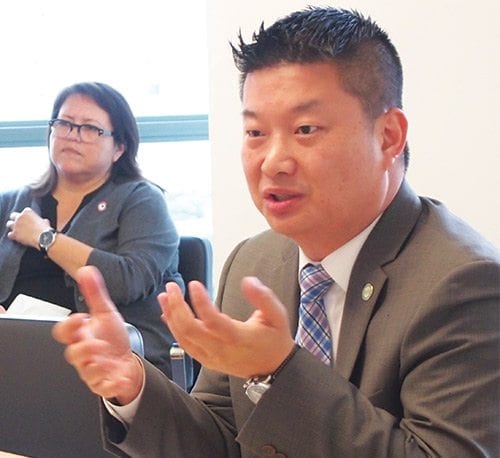Shuttering, consolidating schools remain options, Tommy Chang says
BPS may consider building new schools, closing older facilities with fewer grades

School closings remain under consideration, Boston Public Schools Superintendent Tommy Chang said, answering reporters’ questions at a media roundtable last Thursday. Whether any will happen this year remains speculative but both closures and new school construction are on the table, Chang said.
Parents have long feared that the administration is pushing for school closings, their concerns fueled in part by the release of the now largely-discredited McKinsey report. That assessment said BPS underutilized its facilities’ space and recommended savings costs by shuttering more than 30 schools, but failed to acknowledge student-teacher ratios and distinguish between classroom and non-classroom space.
According to a factsheet distributed at the roundtable, schools deemed under-enrolled or not meeting academic goals and family needs may be closed or merged, while high-performing, high-demand schools also may be expanded or moved to allow for greater enrollment.
Chang also suggested that older school buildings and those with fewer grade offerings are the most likely targets for closure or consolidation, as are those considered underperforming.
Echoing an earlier statement from Mayor Martin Walsh, Chang said the administration wishes to reduce the number of times children transition from school to school. Currently, BPS has 24 different grade offering structures, and officials say they want a more standardized model. Keeping children in the same building for more of their K-12 educational career is expected to help them forge deeper connections with the school community, according to a fact sheet distributed at the meeting.
Some closings also may come if facilities are too old to be renovated sufficiently, Chang said.
“We have some facilities we may not be able to upgrade and if we can’t upgrade them, we’ll have to do something else with them,” he said, noting that 66 percent of BPS’s facilities were built prior to World War II.
Location could be a factor as well. Chang expressed a desire to bring quality schools closer to students’ homes to reduce transit time and costs.
However, Mary Battenfeld, member of the parent group Quality Education for Every Student, warned against seeing this as a method to improve community or finances. Shuttering a school sacrifices its community and takes away what many students come to see as a home, she told the Banner.
“If you close a school, you’re breaking up a community,” Battenefeld said.
Properly consolidating schools requires the buy-in of both communities, and should be enacted gradually, she said. Administrators also must add funding to ensure that children who may be moved out of an underperforming school get the resources and support staff they need at the community they are joining.
“You can’t do it because you think you’re going to save money. For the next few years, the school needs more support,” Battenefeld said.
The other risk of closing schools regarded as low-performing is that they may have other qualities parents value, but that are not measured by metrics such as school tiers. The Agassiz is one such example, she said.
“The family there loved that school and did not see it as a level-four school. They saw it as a school that was their home,” Battenfeld said.
Data on the educational and facilities master plan will be shared publicly prior to any school reconfigurations, Chang said, promising that any process will engage the community and rely on common sense.
“We want to create a school system that is coherent and makes common sense,” Chang said. “All will be done in a respectful way.”
Budgeting
With financial strains expected again next year, Chang also highlighted a desire to trim BPS’ transportation costs — 10 percent of the department’s budget — by planning more efficient routes.
BPS will conduct a fuller assessment of bus route demand through expanded use of tap-cards that track when students get on and off, and providing parents with forms for opting out of bus coverage.
Other budget initiatives include plans to reassess enrollment projections to attain a more accurate picture of each school’s student body — and thus obligated per-student funding allotments — and the establishment of a Advancement Office responsible for pursuing and working with local and national funders. Students will be engaged earlier in the budgeting process this year, and asked to weigh in on how funds should be spent, Chang said.






